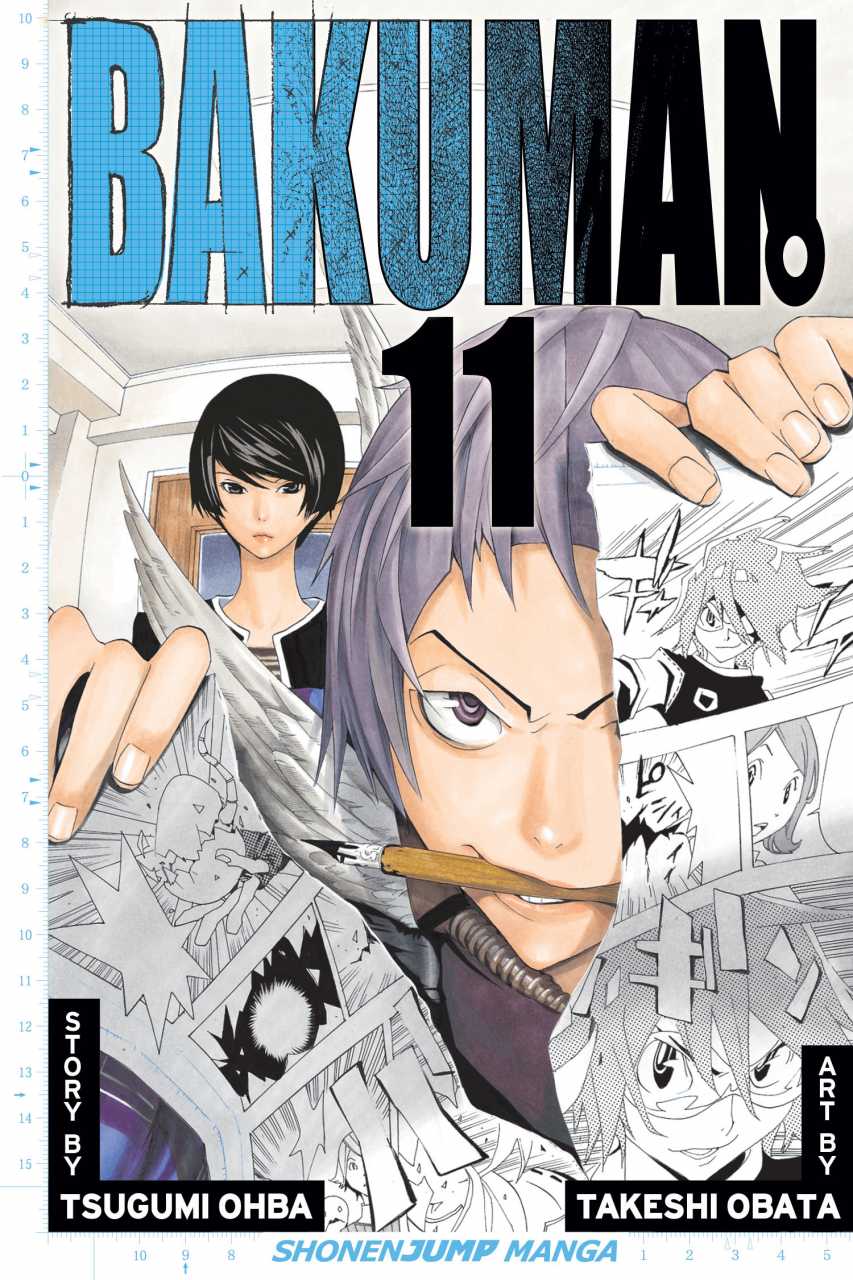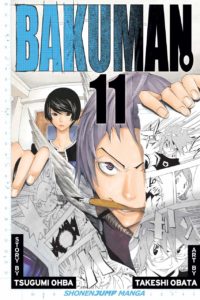Manga Review: Bakuman. Volume 11 story by Tsugumi Ohba, art by Takeshi Obata
Moritaka Mashiro’s uncle was a one-hit manga creator whose work appeared in Weekly Shounen Jump back in the day. After the end of that series, he worked himself to death trying to come up with a new hit. Warned by this example, Moritaka has already discarded the idea of becoming a manga creator in junior high school, even though he’s a talented artist.
But one day Moritaka is tracked down by his book-smart classmate Akito Takagi, who wants to use his writing abilities to plot manga, but isn’t a good artist. Akito suggests teaming up to create comics, as sharing the load should avoid the overwork problem. He also gives Moritaka the nudge needed for the young artist to speak to his long-time crush, Miho Azuki. Turns out she returns the crush, but her ambition is to become a voice actress in anime shows.
The young teens make a pact. The boys will create a manga good enough to become an anime, and Miho will play the part of the female lead. After that, Moritaka and Miho will get married, but until then they won’t pursue an in-person relationship while concentrating on their careers. This decided, they must now learn how to become successful manga creators!
This manga series ran from 2008 to 2012 in Weekly Shounen Jump, and was rather “meta.” Several of the characters were based on actual employees of Jump, and there were frequent mentions of other manga that actually appeared in the magazine, and their creators, who always remained just off-page. The business practices were modeled after those of the real magazine, so it was a peek behind the curtain for fans and aspiring creators.
The creators of Bakuman. had previously created the hit series Death Note and continued to have excellent art and twisty plotlines where smart people try to out-think each other and the readers.
Note that the volume at hand is #11, so there will be spoilers for previous volumes in the next few paragraphs.
After having two series end early for different reasons, our creative duo is skating on thin ice with the senior editor. They have to come up with something that will compete in the popularity polls Jump runs each issue with Crow and +Natural, the two series drawn by genius creator Eiji Nizuma. The first step is complete, thinking up a solid premise, about a group of elementary school students who commit elaborate but harmless pranks.
Now it’s time to come up with character designs, names and the best title to make readers interested in the first chapter, and then in continuing to read the series. The fellows settle on Perfect Crime Party. They also welcome two new art assistants, the pretentiously arty Shuichi Moriya, and the whimsical pleaser Shun Shiratori, as well as their assistant on the previous series, Ichiriki Orihara.
The combination is a success! PCP gets the number one spot in the reader survey for its first chapter. That’s a real ego-booster, but as the weeks pass, the ranking steadily drops. Our heroes are going to need to come up with something truly special if they want to stay in the magazine!
But of course Moritaka and Akito aren’t the only manga creators out there. Aiko Iwase, the writer for +Natural, has come up with a gimmick that boosts that series’ ratings considerably. Bad boy creator Shinta Fukuda just came up with a motorcycle racing series that’s sure to attract attention. And Eiji continues to be a genius.
We also look at some creators who aren’t doing so well. Gloomy shut-in Ryu Shizuka has let his series True Human drift in a direction too fetishy for even the fans of Jump that like the sexy stuff; he’s in danger of cancellation unless his editor finds a way to kick his butt into gear. And talented but slovenly and socially inept former assistant Takuro Nakai is growing bored of farm life in his semi-voluntary exile.
The volume ends with Moritaka and Akito having come up with their big plan, with the results to be revealed in the next volume!
As I’ve noted in other reviews, “work” manga, about what a particular job is like and how to succeed at it, is an area where manga has it all over mainstream American comic books. This is a fine example of the genre, mixing realistic business practices and artistic notes with exaggerated circumstances and a soap-opera set of subplots. There’s an assortment of fun characters, and it’s good that our heroes aren’t the most naturally talented of the bunch.
One iffy part of the manga is the use of female characters. The few creators who are women are not really taken seriously as competition by the male creators, even when they probably should be. Akito has a habit of saying things that are kind of sexist, and it’s not clear if this is supposed to be a character flaw or an example of his intelligence. (One of his early speeches was toned way down in the anime adaptation, which suggests I wasn’t the only one who was uncomfortable.) And is Aiko Iwase constantly undercut by the story because she’s a woman who stands up for herself and wants to be appreciated for her brains, or simply because she’s got a personality that would turn people off even if she was a man?
Overall, this is an excellent series for manga fans who want to see what the creative process for manga is like, or who wish they too could work for Weekly Shounen Jump.


